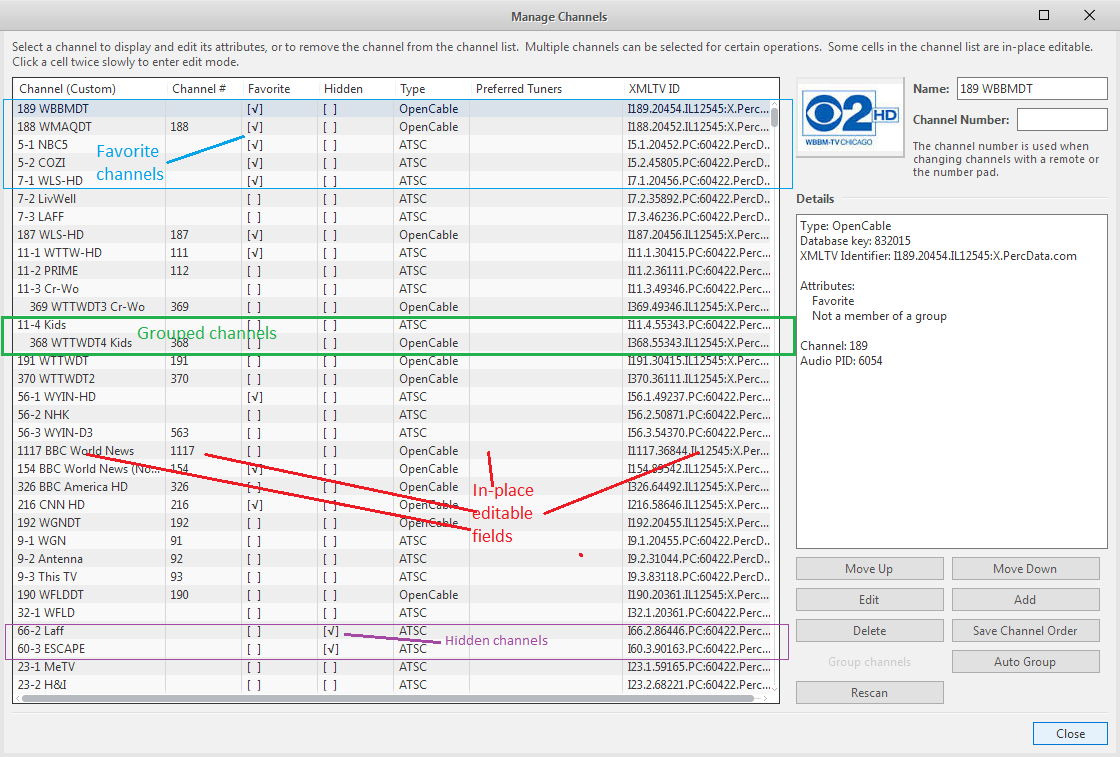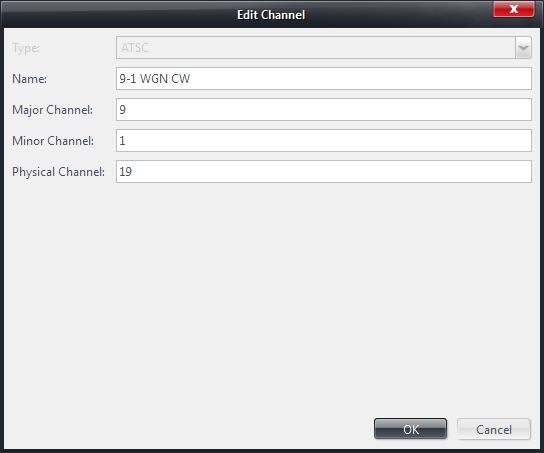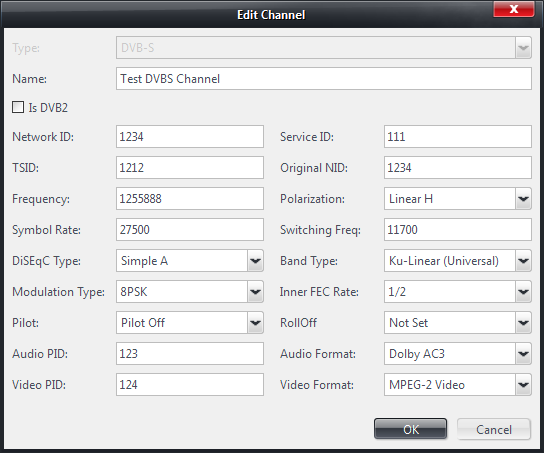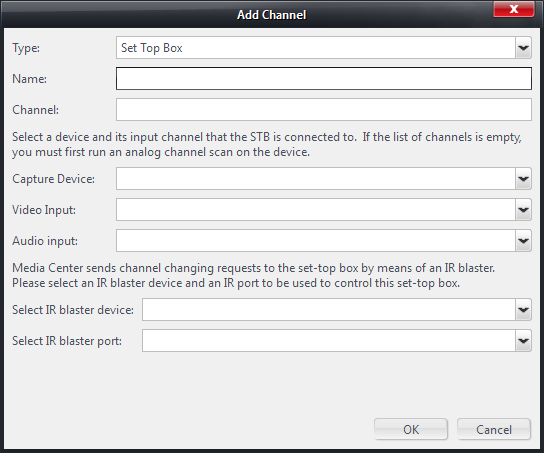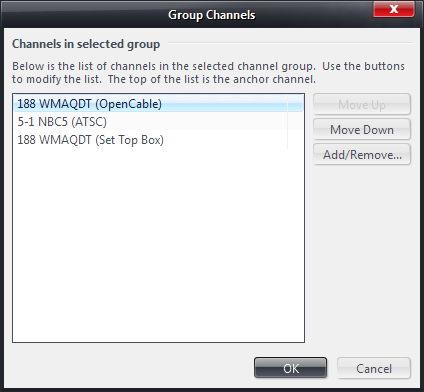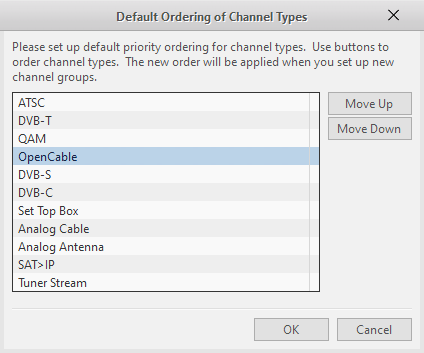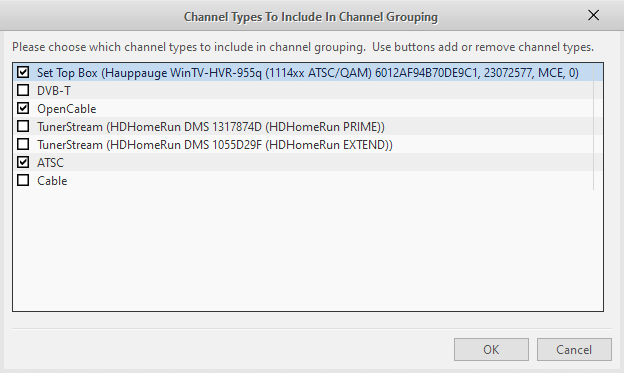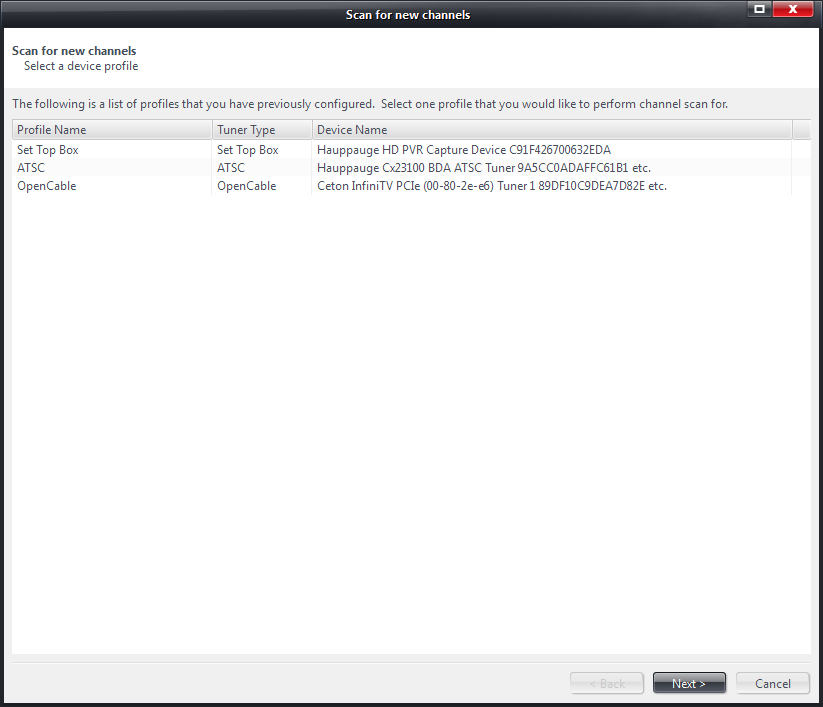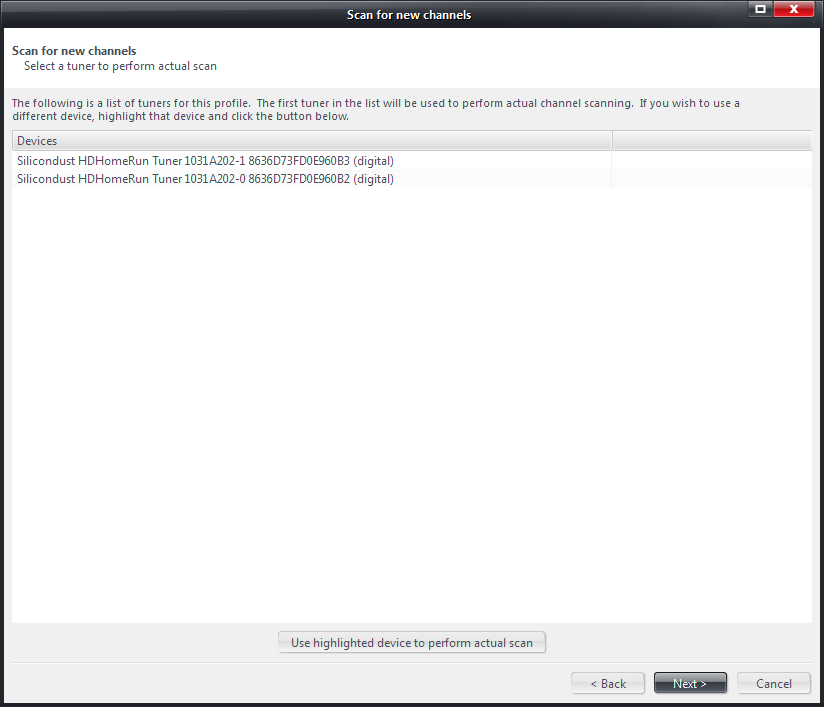Manage TV Channels: Difference between revisions
No edit summary |
|||
| (22 intermediate revisions by the same user not shown) | |||
| Line 2: | Line 2: | ||
== Overview == |
== Overview == |
||
This article is updated to reflect changes made in version 23 and later. The content is still applicable to earlier versions where this tool is relevant. The main difference is that for earlier versions some editable fields are on the right-side of the window, instead of in the list of channels on the left. |
|||
The Manage Channels tool is accessed via MC's Television property page. |
The Manage Channels tool is accessed via MC's Television property page. |
||
To start television property page, go to MC's Standard View and click Television on the left panel, and then click the "TV Options..." button near lower center of the main MC window. Alternatively you can also use Tools menu and select Options... to start MC's property pages and then click Television on the left panel. Once you opened Television property page, click "Manage Channels" in the "Channels" section. |
To start television property page, go to MC's Standard View and click Television on the left panel, and then click the "TV Options..." button near lower center of the main MC window. Alternatively you can also use Tools menu and select Options... to start MC's property pages and then click Television on the left panel. Once you opened Television property page, click "Manage Channels" in the "Channels" section. |
||
For version 24 and higher this tool is also accessible by right-clicking Television tree on the left panel in Standard View, and choose "Manage Channels...". |
|||
Here is a screenshot of Manage TV Channels window: |
Here is a screenshot of Manage TV Channels window: |
||
[[File:Manage Channels.png]] |
[[File:Manage Channels V23 or higher.png]] |
||
'''List of channels''' |
'''List of channels''' |
||
The left side of the window is the list of channels. There are |
The left side of the window is the list of channels. There are seven columns in the list. The first column contains the channel names. The second column is for Channel Number, the third column contains checkboxes for Favorite channels and the fourth column contains checkboxes for Hidden channels. The fifth column is read-only, and contains "Channel Type" field. The sixth and seventh columns are for "Preferred Tuners" and "XMLTV ID" respectively. |
||
The channel list contains all of your channels, including hidden channels and grouped channels. Channels in a group are always displayed together. The top member of a group (also known as the anchor channel) is displayed first, in normal style. The other members (non-top members) are displayed below the top of the group, with a small indentation to the right. |
The channel list contains all of your channels, including hidden channels and grouped channels. Channels in a group are always displayed together. The top member of a group (also known as the anchor channel) is displayed first, in normal style. The other members (non-top members) are displayed below the top of the group, with a small indentation to the right. |
||
| Line 35: | Line 39: | ||
==Channel Details== |
==Channel Details== |
||
The attributes and properties of a selected channel is shown on the right side of the window. Here are the descriptions of each item: |
The attributes and properties of a selected channel is shown either on the right side of the window, or in columns in the channel list on the left. Here are the descriptions of each item: |
||
'''Channel Logo''' |
'''Channel Logo''' |
||
| Line 43: | Line 47: | ||
'''Name''' |
'''Name''' |
||
The edit box shows the channel name. It can be edited. By default, MC puts channel's number in front of the name. For example " |
The edit box shows the channel name. It can be edited. By default, MC puts channel's number in front of the name. For example "189 WBBMDT" as shown in the screenshot above. With version 23 and higher, the channel name can also be edited in the channel list, first column. Click the cell twice in slow succession (also known as slow-double-click) to enter editing mode. |
||
| Line 54: | Line 58: | ||
Channel Numbers are used to change channel with a remote control or the number pad on keyboard. This is important for channel types whose underlying channels are not a single number such as DVB channels, and to a lesser extent ATSC channels. |
Channel Numbers are used to change channel with a remote control or the number pad on keyboard. This is important for channel types whose underlying channels are not a single number such as DVB channels, and to a lesser extent ATSC channels. |
||
Note: In older versions of MC, assigning a channel number to an ATSC channel was important. With newer versions of MC, it is less important since you can enter the ATSC channel number directly using a remote control (e.g. pressing 5 * 1 for channel 5-1). |
Note 1: In older versions of MC, assigning a channel number to an ATSC channel was important. With newer versions of MC, it is less important since you can enter the ATSC channel number directly using a remote control (e.g. pressing 5 * 1 for channel 5-1). |
||
Note 2: In version 23 and higher, this field also appears in the channel list on the left, in the second column ("Channel #"). You can also edit the field in the list. Use slow-double-click method to enter edit mode. |
|||
| ⚫ | |||
There is a column in the channel list on the left side that exist in version 23 and higher only. This is a read-only column showing the Channel Type of each channel (ATSC, DVB-T, STB...). The same info also appears in the large read-only edit box under "Details" on the right side, for all versions where this tool is relevant. |
|||
'''Preferred Tuner''' |
'''Preferred Tuner''' |
||
With version 23 or higher, this field appear as a column in the channel list on the left. Use slow-double-click to enter edit mode. With earlier versions, this is a simple drop-list on the right side. |
|||
For channels types that allow multiple tuners to share the same set of channels (such as ATSC, analog - both OTA and cable, DVB, CableCARD, etc.), you can select a preferred tuner for a given channel. This can be important when your tuners have different sensitivity to different channels. When a channel with a preferred tuner is selected for playback, MC first try loading the preferred tuner, falling back to other tuners if the preferred tuner is busy. By default, MC does not assign a preferred tuner to any channel. |
For channels types that allow multiple tuners to share the same set of channels (such as ATSC, analog - both OTA and cable, DVB, CableCARD, etc.), you can select a preferred tuner for a given channel. This can be important when your tuners have different sensitivity to different channels. When a channel with a preferred tuner is selected for playback, MC first try loading the preferred tuner, falling back to other tuners if the preferred tuner is busy. By default, MC does not assign a preferred tuner to any channel. |
||
| Line 62: | Line 74: | ||
For STB, Capture-only, and Camera types of channels, Preferred Tuner drop list box is disabled because these types of channels require a specific video capture device. |
For STB, Capture-only, and Camera types of channels, Preferred Tuner drop list box is disabled because these types of channels require a specific video capture device. |
||
'''XMLTV Identifier''' |
|||
For version 23 and higher, this field appears in the last column in the list of channels on the left side. It is in-place editable. Use slow-double-click to enter editing mode. |
|||
| ⚫ | |||
For earlier versions, this field appears under the "Details" group as a simple edit box. |
|||
The |
The "XMLTV Identifier" associates a channel with an XMLTV channel ID when you download EPG data from the Internet. The field is filled automatically when you setup EPG and therefore normally should not be changed. There are cases, however, in which you may need to erase the field for a certain channels. |
||
"XMLTV Identifier" is needed for any channel for which programming info is downloaded from the Internet in the format of XMLTV or similar. It is not needed if you use Over-the-Air method for loading EPG data (ATSC |
"XMLTV Identifier" is needed for any channel for which programming info is downloaded from the Internet in the format of XMLTV or similar. It is not needed if you use Over-the-Air method for loading EPG data (ATSC and DVB channels). |
||
There is an option on Television property page, "In Over-the-air EPG scan |
There is an option on Television property page, "In Over-the-air EPG scan, save programs for channels with empty XMLTV ID only". This option is useful if you want to use a combination of OTA and Internet methods for loading EPG data for your ATSC or DVB channels, due to data quality issues for example. In such case, you empty the XMLTV ID field for channels you want EPG data from OTA scan, and leave XMLTV ID in for channels you want EPG data from on-line source. |
||
'''Details''' |
|||
The large edit box under Details is a read only box that contains all other details of a channel. |
The large edit box under Details is a read only box that contains all other details of a channel. |
||
| Line 84: | Line 99: | ||
Other information specific to a channel type, such as major channel, minor channel for ATSC channels, frequency, bandwidth, transportation stream ID etc. for DVB channels. |
Other information specific to a channel type, such as major channel, minor channel for ATSC channels, frequency, bandwidth, transportation stream ID etc. for DVB channels. |
||
==Channel Ordering== |
==Channel Ordering== |
||
| Line 94: | Line 108: | ||
''"Channel (Custom)" - '' Channels are sorted using your saved custom ordering. |
''"Channel (Custom)" - '' Channels are sorted using your saved custom ordering. |
||
''"Channel (123 ABC)" - '' Channels are sorted by channel name, '''without ignoring''' the channel numbers in front of the names. |
''"Channel (123 ABC)" - '' Channels are sorted by channel name, '''without ignoring''' the channel numbers in front of the names. E.g. "5 NBC5" is placed ahead of "7 ABC7". |
||
''"Channel (ABC)" - '' Channels are sorted by channel name only, '''ignoring''' the channel numbers in front of the names. |
''"Channel (ABC)" - '' Channels are sorted by channel name only, '''ignoring''' the channel numbers in front of the names. E.g. "7 ABC7" is placed ahead of "5 NBC5". |
||
''"Channel (Favorite)" - '' Channels are sorted so that your favorite channels are at the top, all hidden channels are at the bottom, and all other channels in the middle. |
''"Channel (Favorite)" - '' Channels are sorted so that your favorite channels are at the top, all hidden channels are at the bottom, and all other channels in the middle. |
||
| Line 210: | Line 224: | ||
Note 3: If all of your selected channels (including a single selection) belong to a single group, the Group button is renamed "Modify Group". Clicking "Modify Group" button brings out the same dialog window as shown above, with all members of the existing group being present in the list. |
Note 3: If all of your selected channels (including a single selection) belong to a single group, the Group button is renamed "Modify Group". Clicking "Modify Group" button brings out the same dialog window as shown above, with all members of the existing group being present in the list. |
||
Note 4: For MC version 27 and higher, and for Windows platform only, if you have a tuner device capable of streaming over your network, for example "HDHomeRun EXTEND", you may end up with both a "traditional" channel type, such as "ATSC", and a "DMS (TunerStream)" channel type. '''You should never group such channels together'''. Grouping them, for example "5-1 NBC5 (ATSC)" with "5.1 NBC5 (TunerStream)" is not only not beneficial, but actually harmful because these types of channels are just different ways a tuner device serves the same TV program. '''In general, you should select one type to use, and hide the channels of the other type.''' Mixing the two types of channels will cause tuner conflicts. This is not an issue for Mac and Linux users because only TunerStream type is available on these platforms. |
|||
===="Auto Group"==== |
===="Auto Group"==== |
||
| Line 216: | Line 231: | ||
Note that auto grouping does not always produce ideal results. '''It is therefore important that you examine that results carefully and make manual adjustment if necessary.''' |
Note that auto grouping does not always produce ideal results. '''It is therefore important that you examine that results carefully and make manual adjustment if necessary.''' |
||
After you click "Auto Group" button, the following window pops up: |
|||
[[File: Default_order_of_channel_types.png]] |
|||
This tool allows you to decide the default priority order of channel types in a group. During the entire Auto Group process, this ordering will be applied. In the screenshot, "ATSC" is on top of the list, followed by "DVB-T", "QAM", etc. In different countries, the applicability of these types differ. If you live in the USA, and you have "ATSC", "QAM" and "OpenCable" channels, then these will be the order of types that maybe applicable. So in a particular group of channels, the ATSC channel will be at the top, followed by QAM and OpenCable. That is the order MC will try, when playing a particular TV program. |
|||
'''For MC version 27 and higher''', after you click OK on the pop up window shown above, a second pop up window shows up, as seen in the next screenshot. |
|||
[[File: Channel_types_to_include_in_auto_grouping.png]] |
|||
This shows a list of channels types with checkboxes. You can check or uncheck any box to select which types of channels are involved in the Auto Grouping process (but of course you need at least two types checked in order for grouping to make sense). For example, as in the screenshot above, only STB, ATSC, and OpenCable types are selected, only these types of channels are considered during the auto grouping process. All other channels are ignored. |
|||
After you click OK on this popup window, MC will work out the grouping and give you a final notification. You should examine the result and manually correct any groups that are not correct or ideal for you. |
|||
Note 1: STB channels and DMS/TunerStream channels are tied to devices. You will have one set of channels for each of such devices. For example, you may have two STB boxes and two HDHomeRun PRIME devices, all serving the same cable channel lineup. Then you will have four sets of channels: |
|||
STB (Hauppauge PVR2) |
|||
STB (Hauppauge WinTV-HVR-955Q) |
|||
TunerStream (HDHomeRun PRIME 1234AAAA) |
|||
TunerStream (HDHomeRun PRIME AAAA2222) |
|||
Since these channels are served by different devices, they can all be grouped. |
|||
Note 2: For Mac and Linux users, even though you only have TunerStream channels, channel grouping still applies if you have multiple devices. |
|||
===="Rescan"==== |
===="Rescan"==== |
||
Latest revision as of 16:08, 24 February 2021
Any time you need to edit some aspects of your television channels, you run Manage Channels tool.
Overview
This article is updated to reflect changes made in version 23 and later. The content is still applicable to earlier versions where this tool is relevant. The main difference is that for earlier versions some editable fields are on the right-side of the window, instead of in the list of channels on the left.
The Manage Channels tool is accessed via MC's Television property page.
To start television property page, go to MC's Standard View and click Television on the left panel, and then click the "TV Options..." button near lower center of the main MC window. Alternatively you can also use Tools menu and select Options... to start MC's property pages and then click Television on the left panel. Once you opened Television property page, click "Manage Channels" in the "Channels" section.
For version 24 and higher this tool is also accessible by right-clicking Television tree on the left panel in Standard View, and choose "Manage Channels...".
Here is a screenshot of Manage TV Channels window:
List of channels
The left side of the window is the list of channels. There are seven columns in the list. The first column contains the channel names. The second column is for Channel Number, the third column contains checkboxes for Favorite channels and the fourth column contains checkboxes for Hidden channels. The fifth column is read-only, and contains "Channel Type" field. The sixth and seventh columns are for "Preferred Tuners" and "XMLTV ID" respectively.
The channel list contains all of your channels, including hidden channels and grouped channels. Channels in a group are always displayed together. The top member of a group (also known as the anchor channel) is displayed first, in normal style. The other members (non-top members) are displayed below the top of the group, with a small indentation to the right.
Channels in the list can be selected by a mouse click. Multiple channels can be selected by holding down SHIFT key while clicking, or by holding down CTRL key while clicking, just as in any other normal list selection operations.
Channel info
Most of the right side of the window is for showing properties of the selected channel, or the first selected channel in case of multiple selection.
Buttons
In the right lower portion of the window there are several buttons that can be used for performing certain operations on the selected channels. Depending on the number and type of channels selected, some buttons maybe disabled.
Right-click menu
You can display a context menu by right-clicking a selected channel, or a group of selected channels. The menu items that appear in the menu depend on the number of channels selected, or the type of channels selected.
Channel Details
The attributes and properties of a selected channel is shown either on the right side of the window, or in columns in the channel list on the left. Here are the descriptions of each item:
Channel Logo
If a channel logo has been added to the channel, it is displayed, to the left of "Name" and "Channel Number". If you have not assigned a logo to the channel, a default image is displayed.
Name
The edit box shows the channel name. It can be edited. By default, MC puts channel's number in front of the name. For example "189 WBBMDT" as shown in the screenshot above. With version 23 and higher, the channel name can also be edited in the channel list, first column. Click the cell twice in slow succession (also known as slow-double-click) to enter editing mode.
Channel Number
The is the user-assignable channel number field. It should not be confused with the underlying channel number that is sent to the tuner each time you tune to the channel. Even though in most cases Channel Number field is the same as the actual channel number, but it does not have to be the same. For example, for ATSC channel, channel number is in "major channel - minor channel" format, whereas the "Channel Number" field should be a single numerical value. So you can, for example, assign "Channel Number" 5001 to ATSC channel 5-1. If your cable company's lineup puts a particular channel on a number that is not the same as the channel's traditional channel number, you can assign the traditional channel number in the "Channel Number" field. For example, you can assigned "Channel Number" 11 to cable channel 191 because channel 191 is the HD version of traditional channel 11.
When MC scans for channels, it assigns the "Channel Number" automatically if such data is available. For example, for cable channels in the USA, either CableCARD or STB type, we just use the actual cable channel number. For DVB-T, "Channel Number" is assigned if the number is found during the scan. For ATSC channel, they are not automatically assigned.
Channel Numbers are used to change channel with a remote control or the number pad on keyboard. This is important for channel types whose underlying channels are not a single number such as DVB channels, and to a lesser extent ATSC channels.
Note 1: In older versions of MC, assigning a channel number to an ATSC channel was important. With newer versions of MC, it is less important since you can enter the ATSC channel number directly using a remote control (e.g. pressing 5 * 1 for channel 5-1).
Note 2: In version 23 and higher, this field also appears in the channel list on the left, in the second column ("Channel #"). You can also edit the field in the list. Use slow-double-click method to enter edit mode.
Type
There is a column in the channel list on the left side that exist in version 23 and higher only. This is a read-only column showing the Channel Type of each channel (ATSC, DVB-T, STB...). The same info also appears in the large read-only edit box under "Details" on the right side, for all versions where this tool is relevant.
Preferred Tuner
With version 23 or higher, this field appear as a column in the channel list on the left. Use slow-double-click to enter edit mode. With earlier versions, this is a simple drop-list on the right side.
For channels types that allow multiple tuners to share the same set of channels (such as ATSC, analog - both OTA and cable, DVB, CableCARD, etc.), you can select a preferred tuner for a given channel. This can be important when your tuners have different sensitivity to different channels. When a channel with a preferred tuner is selected for playback, MC first try loading the preferred tuner, falling back to other tuners if the preferred tuner is busy. By default, MC does not assign a preferred tuner to any channel.
For STB, Capture-only, and Camera types of channels, Preferred Tuner drop list box is disabled because these types of channels require a specific video capture device.
XMLTV Identifier
For version 23 and higher, this field appears in the last column in the list of channels on the left side. It is in-place editable. Use slow-double-click to enter editing mode.
For earlier versions, this field appears under the "Details" group as a simple edit box.
The "XMLTV Identifier" associates a channel with an XMLTV channel ID when you download EPG data from the Internet. The field is filled automatically when you setup EPG and therefore normally should not be changed. There are cases, however, in which you may need to erase the field for a certain channels.
"XMLTV Identifier" is needed for any channel for which programming info is downloaded from the Internet in the format of XMLTV or similar. It is not needed if you use Over-the-Air method for loading EPG data (ATSC and DVB channels).
There is an option on Television property page, "In Over-the-air EPG scan, save programs for channels with empty XMLTV ID only". This option is useful if you want to use a combination of OTA and Internet methods for loading EPG data for your ATSC or DVB channels, due to data quality issues for example. In such case, you empty the XMLTV ID field for channels you want EPG data from OTA scan, and leave XMLTV ID in for channels you want EPG data from on-line source.
Details
The large edit box under Details is a read only box that contains all other details of a channel.
Information included in the box are:
Channel type - ATSC, DVB-T, Analog Cable, STB, Clear QAM, etc.
Channel database key - unique identifier of a channel in MC's database.
Attributes - whether the channel is favorite, hidden, or grouped.
Other information specific to a channel type, such as major channel, minor channel for ATSC channels, frequency, bandwidth, transportation stream ID etc. for DVB channels.
Channel Ordering
When Manage TV Channels window is initially displayed, the channels in the list are shown in custom sorting order which is saved in an options file. If you have never configured a custom sorting order, then the custom order is the same as "sorting by channel name without ignoring the channel numbers in front".
You can change the display order of the channels by clicking the channel header on the top of the list. Every click changes the channel order to the next built-in ordering scheme. The header text changes accordingly:
"Channel (Custom)" - Channels are sorted using your saved custom ordering.
"Channel (123 ABC)" - Channels are sorted by channel name, without ignoring the channel numbers in front of the names. E.g. "5 NBC5" is placed ahead of "7 ABC7".
"Channel (ABC)" - Channels are sorted by channel name only, ignoring the channel numbers in front of the names. E.g. "7 ABC7" is placed ahead of "5 NBC5".
"Channel (Favorite)" - Channels are sorted so that your favorite channels are at the top, all hidden channels are at the bottom, and all other channels in the middle.
"Channel (123)" - Channels are sorted by the "Channel Number" field. See description of "Channel Number" field above.
"Channel (Type)" - Channels are sorted by channel type. For example, all ATSC channels are at the top, OpenCable channels in the middle, and Set-top box channels are at the bottom.
Besides the built-in channel ordering schemes, you can also manually change orders of channels by using the "Move Up" and "Move Down" buttons.
Note 1: When you reach a channel ordering that you like, you can click "Save Channel Order" button to make it your "Custom" ordering.
Note 2: The channels list in Standard Television view can be sorted by clicking the Channel header repeatedly, just like in Manage TV Channels window as described here.
Operations
The operations available depend on the channel selected. There are two ways most operations can be performed: by clicking a button, or by right-click menu.
Buttons:
"Move Up" / "Move Down"
Click these buttons to move a selected channel, or a group of selected channels, up or down the list, to perform manual ordering of the channel list.
Useful hint:
To move a single channel, or a small group of channels, over a large number of steps, try selecting the large number of channels just above or below the channels you intend the move, and move those in opposite direction. For example, if you want to move channel 100 and channel 101 to the top of the list, instead of selecting these two channels, and clicking "Move Up" 99 times, you can select all channels above these two channels, and click "Move Down" twice to achieve the same effect.
"Save Channel Order"
After you have changed channel order on the channel list, you can click this button to save the order. This saved order becomes your default "Custom" channel order. Channels will be displayed in this order in Theater View Guide, and in Standard Television View.
Note: If you use "Move Up" or "Move Down" button to change the channel order, and do not click "Save Channel Order" button afterwards, you will be reminded to save channel order when you click the "Close" button. If you only changed channel ordering by clicking the Channel header (built-in ordering schemes), such reminder will not be given. So if you want to save the channel ordering in such case, you should click "Save Channel Order" button.
"Edit"
Click Edit button to edit the channel details of a single selected channel. If multiple channels are selected, this button is disabled.
Normally one would not need to edit any channel details. There are some situations when this button may be useful. For example, if your TV station made some changes to their channels, and you know what the changes are, you may edit the channels instead of re-scanning.
What appears after you click the Edit button depends on the type of the channel you try to edit, ranging from the simplest dialog for Analog Cable editing to more complicated DVB-S channel editing.
The following is a screenshot of editing an ATSC channel.
The next example is for DVB-S:
The fields on the dialog window are mostly self-explanatory. Notice that the Type field is disabled since you are not allowed to change the channel type.
"Add"
This button is used to manually add a new channel. If you know all the parameters of a new channel, it maybe faster to add it manually than re-running channel scan wizard.
The dialog window that appears after you click the Add button is very similar to those for Edit button. The Type field is not disabled, so you can use it to select the correct type of channel you want to add. The type field is pre-selected for you, according to the type of channel that had been selected when you click Add button. So to add a new DVB-S channel, you can first select an exiting DVB-S channel before clicking the Add button. This way "DVB-S" is already selected for you, and all empty fields relevant to DVB-S are enabled.
Here is a screenshot of the dialog when you try adding an STB channel:
"Delete"
Use this button to delete one or more selected channels.
Note: It is usually better to simply hide a channel instead of deleting a channel. If you ever need to rescan for new channels, the deleted channel may come back. On the other hand if you only hide it, rescanning will not change its hidden status.
"Group"
Use this button to group a number of selected channels into one group. The button is disabled unless more than one channels are selected.
Channel grouping is useful for consolidating channels that provide equivalent programming content. After channels are grouped, only one channel entry appears in the programming guide. When viewing or recording a show aired on channels in the group, MC automatically select an available tuner. Note that it is generally not beneficial to group multiple channels from the same provider.
For example, suppose in your local area OTA ATSC channel 5-1 (HD) is also provided by a particular cable provider on channel 5 (SD version) and channel 188 (HD version). Assuming that you have ATSC tuners, and CableCARD tuners, as well as a set-top box, then you would have 5 channels that are equivalent:
Channel 5-1 (ATSC, HD)
Channel 5 (OpenCable, SD)
Channel 188 (OpenCable, HD)
Channel 5 (STB, SD)
Channel 188 (STB, HD).
The best practice, assuming that you prefer HD channels to SD channels, is to disable both 5 (OpenCable) and 5 (STB), and group channels 5-1, and both 188 into a group.
If you do not want to disable the SD channels, (for example you want to occasionally use SD channels instead of HD channels), you should just leave the SD channels as independent channels, outside of the HD channel group.
Here is an example of what happens when you click the Group button, after selecting 188 WMAQDT (OpenCable), 188 WMAQDT (STB), and 5-1 NBC5 (ATSC):
On this dialog window you may use the buttons to modify the group (change the order, or add more channels to the group, or remove a channel from the group). The channel on the top of the group list is the Top member of the group (also known as the anchor channel). It is this channel that appears in the guide. When MC selects a tuner for viewing or recording, it uses the order presented here. So in the example screenshot above, when playing channel 188, MC first try finding an OpenCable tuner to serve this channel. It falls back to an ATSC tuner if all OpenCable tuners are busy. If MC can not find a free ATSC tuner, it will try using an STB tuner.
Note 1: The Group button is disabled if you only select one channel that is not a member of any group.
Note 2: The Group button is also disabled if the selected multiple channels belong to multiple groups. So if you ever need to merge two groups, you need to ungroup one of the groups, and then let the ungrouped members join the second group.
Note 3: If all of your selected channels (including a single selection) belong to a single group, the Group button is renamed "Modify Group". Clicking "Modify Group" button brings out the same dialog window as shown above, with all members of the existing group being present in the list.
Note 4: For MC version 27 and higher, and for Windows platform only, if you have a tuner device capable of streaming over your network, for example "HDHomeRun EXTEND", you may end up with both a "traditional" channel type, such as "ATSC", and a "DMS (TunerStream)" channel type. You should never group such channels together. Grouping them, for example "5-1 NBC5 (ATSC)" with "5.1 NBC5 (TunerStream)" is not only not beneficial, but actually harmful because these types of channels are just different ways a tuner device serves the same TV program. In general, you should select one type to use, and hide the channels of the other type. Mixing the two types of channels will cause tuner conflicts. This is not an issue for Mac and Linux users because only TunerStream type is available on these platforms.
"Auto Group"
Use this button to let Media Center try automatically grouping the channel. MC uses channel names to make groups.
Note that auto grouping does not always produce ideal results. It is therefore important that you examine that results carefully and make manual adjustment if necessary.
After you click "Auto Group" button, the following window pops up:
This tool allows you to decide the default priority order of channel types in a group. During the entire Auto Group process, this ordering will be applied. In the screenshot, "ATSC" is on top of the list, followed by "DVB-T", "QAM", etc. In different countries, the applicability of these types differ. If you live in the USA, and you have "ATSC", "QAM" and "OpenCable" channels, then these will be the order of types that maybe applicable. So in a particular group of channels, the ATSC channel will be at the top, followed by QAM and OpenCable. That is the order MC will try, when playing a particular TV program.
For MC version 27 and higher, after you click OK on the pop up window shown above, a second pop up window shows up, as seen in the next screenshot.
This shows a list of channels types with checkboxes. You can check or uncheck any box to select which types of channels are involved in the Auto Grouping process (but of course you need at least two types checked in order for grouping to make sense). For example, as in the screenshot above, only STB, ATSC, and OpenCable types are selected, only these types of channels are considered during the auto grouping process. All other channels are ignored.
After you click OK on this popup window, MC will work out the grouping and give you a final notification. You should examine the result and manually correct any groups that are not correct or ideal for you.
Note 1: STB channels and DMS/TunerStream channels are tied to devices. You will have one set of channels for each of such devices. For example, you may have two STB boxes and two HDHomeRun PRIME devices, all serving the same cable channel lineup. Then you will have four sets of channels:
STB (Hauppauge PVR2)
STB (Hauppauge WinTV-HVR-955Q)
TunerStream (HDHomeRun PRIME 1234AAAA)
TunerStream (HDHomeRun PRIME AAAA2222)
Since these channels are served by different devices, they can all be grouped.
Note 2: For Mac and Linux users, even though you only have TunerStream channels, channel grouping still applies if you have multiple devices.
"Rescan"
If for some reason you need to rescan a set of channels, you can use this button. For example, you may use this when your TV stations made changes that require rescan. You may also use this function if your initial scan did not find all channels due to tuner quality issues, and you want to rescan using a different tuner.
Upon clicking the Rescan button, you will be presented with this wizard window:
It presents a list of previously configured profiles. You should select one profile for which you want to rescan channels, and then click the Next button.
If the list of profiles is empty, you should quit this tool and run television Setup wizard instead.
If the profile you selected is a type that requires using an actual tuner to perform scanning, such as ATSC, DVB types, the next step will present a list of tuners for you to choose from.
You should select the tuner that you want to use for this rescan operation, and click "Use highlighted device to perform actual scan" before clicking the Next button. By default, the first device on the list will be used to perform scanning.
Click Next to start scanning.
Right-click Menu
The right-click menu offers alternative methods of operation on selected channels. Many menu commands are equivalent to corresponding buttons, but there a commands that are only available on the menu. The menu commands are divided into 5 groups.
"Add to Favorites" / "Remove from Favorites"
Use these to put channels into Favorite channels, or remove them from the group.
Using these menu commands is convenient when you want to set a large number of channels as favorite channels, or remove a large number of channels from Favorites. You can select all channels you want to perform the same operation and choose the right-click menu command. This is obviously more efficient than clicking the checkboxes on each channel one-by-one.
"Hide" / "Unhide"
Use these to hide a number of selected channels, or remove their hidden attribute.
Again, these are more efficient than using checkboxes when using them on multiple channels.
"Move up" / "Move down"
Equivalent to corresponding buttons.
"Group Channels" / "Ungroup channels" / "Auto group this channel" / "Change default channel type order for grouping"
Group Channels command is disabled if only one channel is selected, or if more channels are selected but they belong to more the one group already. It is enabled if multiple channels are selected, and selected channels include at least one ungrouped channel and and other selected channels belong to at most one group. When this command is used, the selected channels are put into one group.
Ungroup Channels command is enabled only if some selected channels belong to some groups. This will remove selected channels from their respective groups.
Auto group this channel is enabled if a single ungrouped channel is selected. Running this command will make MC look for suitable channels to be grouped with this channel.
Change default channel type order for grouping command is available only on the right-click menu, simply because there is no short enough phrase that can be used as button text. This command allows you to order default channel type ordering when running "Auto group" commands. Auto grouping will put channels in an order consistent with this default ordering scheme.
This submenu is enabled only if a single channel is selected. The commands are the same as those found elsewhere in the program for cover arts. Most commands in this submenu can be used to acquire a channel logo image for a selected channel.
The commands that are most useful are the following:
Add from file - load an image from a file.
Get from scanner - get an image by running a scanner and save it as channel logo.
Paste from clipboard (image or URL) - paste an image of URL of an image that has been copied to clipboard.
Other commands that are not really useful or even are not appropriate to use in this context (of getting channel logos) will not be discussed here.
